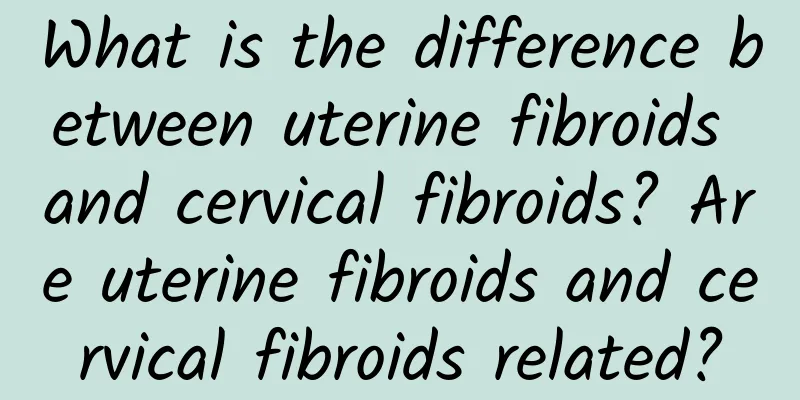What is the difference between uterine fibroids and cervical fibroids? Are uterine fibroids and cervical fibroids related?

|
Uterine fibroids and cervical fibroids are two common gynecological diseases. Although they both belong to the category of fibroids, there are some differences in causes, symptoms, and treatments. This article will introduce the differences between uterine fibroids and cervical fibroids in detail and explore the relationship between them. Uterine fibroids are noncancerous tumors that grow in the uterine wall and are made up of smooth muscle cells beneath the endometrium. Cervical fibroids are tumors that grow on the cervical wall and are also made up of smooth muscle cells. Therefore, the difference between the two is the location of their growth. The symptoms of uterine fibroids and cervical fibroids are also different. Symptoms of uterine fibroids include irregular menstruation, increased menstrual flow, prolonged menstruation, pelvic pain, etc., and sometimes they can cause compression of the urethra and rectum, resulting in urination difficulties and constipation. The main symptoms of cervical fibroids include abnormal vaginal bleeding, especially vaginal bleeding after sexual intercourse. Therefore, intense sexual intercourse may aggravate the bleeding of cervical fibroids. In addition, the two also differ in treatment methods. For uterine fibroids, the treatment method usually depends on the severity of the disease and the female's fertility. Mild uterine fibroids can be relieved by medication. If the symptoms are severe or affect the female's fertility, surgery may be required to remove the uterine fibroids. For cervical fibroids, in general, if the fibroids are asymptomatic and stable in size, special treatment is usually not required. However, if the fibroids cause severe bleeding, surgical removal may be required, or methods such as cryosurgery may be chosen to eliminate the symptoms. In summary, uterine fibroids and cervical fibroids are significantly different in their location, symptoms, and treatment methods. However, it should be noted that both types of fibroids are gynecological diseases and may have a certain impact on women's health. Therefore, it is very important for women to have regular gynecological examinations and maintain good living habits. [Popular Science Introduction] Fibroids are a common benign tumor, mainly composed of smooth muscle cells or fibers. In addition to uterine fibroids and cervical fibroids, there are other types of fibroids, such as ovarian fibroids and fallopian tube fibroids. Female patients are more likely to suffer from fibroids when they are older, and their occurrence is related to genetic factors, hormone levels, and lifestyle habits. The treatment of fibroids varies, depending on the location, size, and severity of the symptoms of the fibroids. For women with fibroids, it is very important to seek medical attention in time and follow the doctor's advice for treatment. |
>>: What kind of surgery can be done for large uterine fibroids? ...
Recommend
What are the causes of irregular menstruation? Can excessive mental stress also cause irregular menstruation?
Menstruation is something that happens to girls e...
How does the hospital treat endometrial tuberculosis?
How does the hospital treat endometrial tuberculo...
Three colors of blood in threatened abortion
Threatened abortion refers to the symptoms of som...
Expert introduction: Treatment of ectopic pregnancy
As for the treatment of ectopic pregnancy, we kno...
What to do if you have cervical warts
What should I do if I have cervical warts? Cervic...
The three major causes of cervical erosion in women. How to prevent cervical erosion in women
Asymptomatic cervical erosion does not require an...
What is the best thing to eat on the first day after an abortion?
Abortion is a common gynecological surgery. A rea...
How to eat to lose weight in spring? Nutritionists drink this secret soup
The spring thunder sounds and everything wakes up...
The best way to treat cervical erosion
Cervical erosion is a common gynecological diseas...
Does an ectopic pregnancy implant on the ovary require surgery?
Ectopic pregnancy implantation on the ovary requi...
Is amenorrhea a symptom of irregular menstruation?
Amenorrhea is one of the symptoms of irregular me...
High fiber and low fat! Eat loofah, clam and oatmeal porridge
"Luffa and Clams" is a popular dish in ...
How thick is the endometrium before you get cancer?
Cancer cannot usually be diagnosed based on the t...
Etiological classification of patients with hyperprolactinemia
In daily life, we need to pay attention to hyperp...
Three major hazards of cervical precancerous lesions to women
Cervical precancerous lesions are one of the comm...









